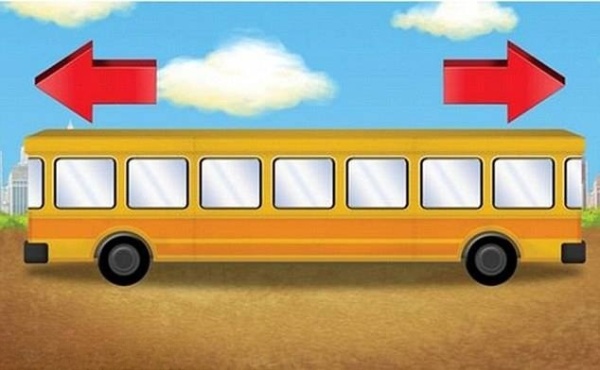Puzzles and riddles that test our observational skills always grab attention, and the “Which Direction Is the Bus Traveling?” challenge is no different. At first glance, it might look like a simple picture of a bus, but hidden within this seemingly ordinary image is a clever puzzle waiting to be solved. So, how do you determine the direction of the bus? Let’s break it down step by step and uncover the answer.
The Power of Simple Visual Puzzles

Visual puzzles like this one are designed to make you think critically about what you’re seeing. They often play with your perception, forcing you to analyze the smallest details in the image. The beauty of this challenge lies in its simplicity—there’s no obvious indication of direction, and that’s precisely what makes it so intriguing.
Examining the Bus in Detail
The image shows a yellow bus with two red arrows on either side, seemingly pointing left and right. The arrows don’t actually give us any useful information; they’re there to distract you. The real answer lies in analyzing the bus itself.
Here’s what we know about the bus from the image:
- No Door Is Visible: Typically, buses have doors for passengers to enter and exit. If the door isn’t visible, it means the bus’s door is likely on the opposite side.
- Symmetry of the Bus: The bus is symmetrical, making it difficult to determine the front and back just by looking at its shape.
- Windows and Wheels: The windows and wheels are identical on both sides, adding to the challenge of figuring out the bus’s orientation.
Step 1: Consider the Door Placement
In most buses, the passenger door is located on the side that’s not shown in the image. This means the door is likely on the other side of the bus. In countries where people drive on the right side of the road, passenger doors are usually on the right-hand side of the vehicle. Conversely, in countries where people drive on the left side of the road, passenger doors are on the left-hand side.
So, based on this clue, the direction of the bus depends on which side of the road the vehicle operates.
Step 2: Analyze the Context of the Image
The image doesn’t provide additional context like road markings, traffic signs, or surrounding scenery. However, if we assume that this is a standard bus designed for public transport, the side of the road it operates on becomes a key factor in solving the puzzle.
For example:
- If the country drives on the right side of the road, the bus is moving left in the image because the passenger door is on the other (hidden) side.
- If the country drives on the left side of the road, the bus is moving right in the image for the same reason.
Step 3: Deciphering the Clue Hidden in the Wheels
Another subtle but crucial detail is the placement of the wheels and how the bus is depicted in the image. Since the bus’s doors are not visible, and the perspective is consistent with typical right-hand driving countries (common globally), the most likely answer is that the bus is traveling left.
Conclusion
So, which direction is the bus traveling? Based on the absence of a visible door and common driving norms, the most likely answer is left—assuming the image depicts a bus in a country where people drive on the right side of the road. This puzzle is a great reminder of how simple visual challenges can test our logic, observation, and reasoning skills.
Next time you encounter a puzzle like this, take a step back, analyze the details, and think critically. It’s not just about finding the answer—it’s about enjoying the process of discovery. Now, go ahead and share this puzzle with your friends and see how quickly they can solve it!

